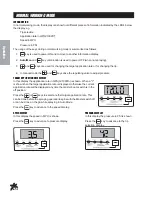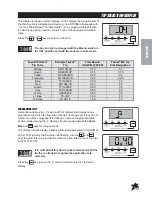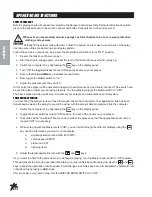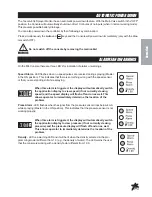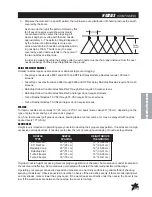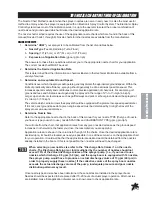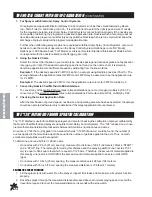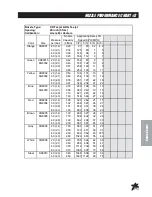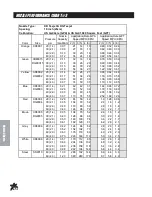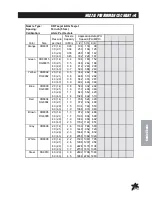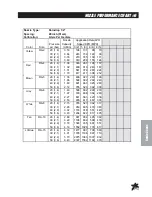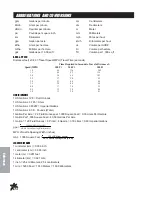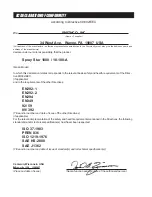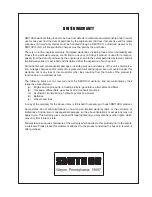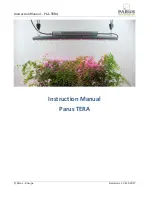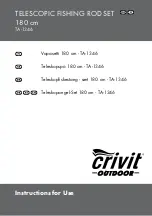
30
Spraying Procedures
THE NOZZLE CHART METHOD OF CALIBRATION
(CONTINUED)
5. For Sprayer with Electronic Spray Control Systems.
On sprayers equipped with Electronic Spray Control Systems such as those manufactured by Raven
Ind., Micro-Trak Co. and Dickey-John Co., it is still important to select the right type and size of nozzle
for the required operation. Electronic Spray Control Systems cannot function properly if the nozzles are
not capable of delivering the programmed (desired) application rate. Nozzles which are too large will not
develop adequate pressure or satisfactory spray patterns. Nozzles which are too small will not allow the
discharge of spray material at the programmed application rate.
Further, when calibrating sprayers which are equipped with Electronic Spray Control Systems, care must
be taken to use the mode of operation on the Spray Control System (Gallons per acre “US” Mode);
Gallons per 1,000 Square Feet (“Turf” Mode); or Liters per Hectare (Standard International Model), which
corresponds with the nozzle calibration charts (gpa, gpt or lph).
6. Using the Nozzle Charts.
Select the correct chart based on your nozzle type, nozzle spacing and desired expression of application
rate (gpa, gpt or lph). If the desired operating speed is not found on the nozzle chart, it is simple to
determine application rate at different speeds by estimating from the known facts.
Example 1: If the desired speed is 2
1
/
2
MPH (4 kph) on a sprayer using Raindrop nozzles (Chart 5). The
average between the application rates for 2 MPH and 3 MPH may be assumed to be the application rate
for 2
1
/
2
MPH.
Example 2: The desired speed is 6 MPH. Use the application rate column for 3 MPH a divide by 2.
7. Converting Nozzle Chart Method to British Gallons.
To convert any of the Gallon Per Acre rates to Imperial Gallons per acre, (Imp gpa) multiply by 0.83. To
convert any of the Liter Per Hectare rates to Imperial Gallons Per Hectare (Imp GPH), multiply by 0.22.
8. Checking the Actual Application Rate.
After the combination of ground speed, nozzle size and operating pressure has been selected, the sprayer
should be operated with water only to determine if the target application rate is achieved.
THE “128” METHOD OF BOOM SPRAYER CALIBRATION
The “128” Method is useful for calibrating sprayers and also for checking the calibration of sprayer calibrated by
the Nozzle Chart Method and sprayers using Electronic Spray Control Systems. The “128” is based on a conve-
nient mathematical relationship that exists between US Gallons, liquid ounces and acres.
An ounce is 1/128th of a (US) gallon. If an area which was “1/128th of an acre” could be found, the number of
ounces applied to that small area would be equal to the number of gallons applied to the acre Thus, no math-
ematical computations would be required.
To determine an area which is 1/128 of an acre:
• On nozzles with 20 inch (51 cm) spacing, measure off a distance of 204 ft (62 meters). Mark a “START”
and a “STOP” line. The rectangle formed by this distance and the spraying width of one nozzle 20" (51
cm) is equal to 340 square feet which is equal to 1/128 acre. Therefore, the amount of material applied to
this area by one nozzle in OUNCES is the same amount of material applied to an acre in GALLONS
(gpa).
• On nozzles with 10 inch (25 cm) spacing, the measure distance is 408 feet (124 meters).
• On nozzles with 30 inch (76 cm) spacing the measured distance is 136 feet (41 meters).
CALIBRATING FOR APPLICATION
1. Fill the sprayer tank with water. Run the sprayer, inspect it for leaks and make sure all systems function
properly.
2. Drive the sprayer through the measured distance discussed above at normal spraying speed, record the
travel time required to cover the measured distance in seconds with a stopwatch.
Summary of Contents for Spray Star 1006
Page 26: ...24 Schematics WIRING SCHEMATIC HYDRAULIC SCHEMATIC ...
Page 43: ...41 NOTES ...
Page 46: ...Part 75 15 010799 ...



